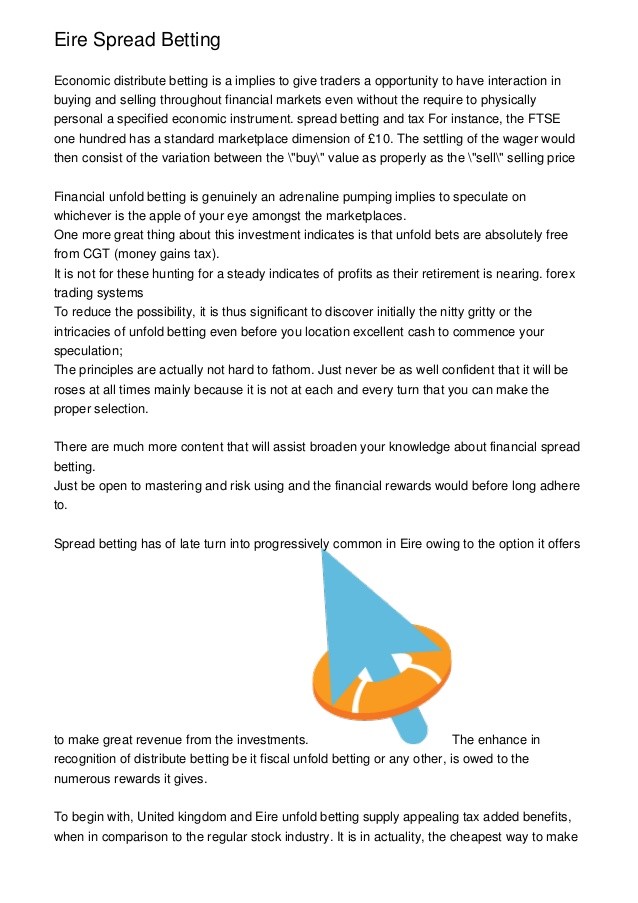What is Spread Betting_1
Post on: 16 Март, 2015 No Comment

Video: How Does Spread Betting Work? — InterTrader
A simple spread bet
If the FTSE 100 currently stands at 6641.6, InterTrader.com may quote 6641.1 (the sell price) to 6642.1 (the buy price) for our UK 100 (Rolling Daily) bet.
This quote (which has a 1-point spread) allows you the opportunity to bet that the value of this market will fall or rise. If you believe that the value of the UK 100 will fall, you should sell (or make a Down Bet) at 6641.1, or if you think it will rise, you would buy (or make an Up Bet) at 6642.1.
Assuming you decide to sell, the following example is based on a bet of £5 per point movement:
The market falls and you decide you would like to realise your profit. The FTSE 100 now stands at 6518.6 and our UK 100 quote is 6518.1-6519.1. You will need to buy at 6519.1 to close your original sell bet. Similarly, if you had opened your position with a buy bet, you would need to sell to close.
In this example, if you close your position by buying at 6519.1 your winnings would be calculated as follows: 6641.1 – 6519.1 = 122 x £5 = £610.
Obviously if, instead of falling, the market rises above the level at which you first sold, you would incur a loss, realised when you close your position.
If you are new to spread betting we strongly recommend that you open an online Demo Account and refer to our online User Manual for full instructions on placing a bet.
What is margin?
What separates spread betting from traditional types of investment is the ability to trade ‘on margin’. Margin trading allows you to command larger position sizes using only a small deposit. For example, when trading on 10:1 margin, you only need to deposit 10% of the total value of the position. You could open a position worth $100 in Microsoft stock and only deposit $10 for that trade.
When trading on margin (also known as taking a ‘leveraged’ position) you can greatly enhance the potential return on your capital. You should note though that margin trading creates an equally large possibility for losses, if the price moves in an unfavourable direction. Experienced traders generally recommend that margin trading is approached with a conservative mindset.
How to calculate Initial Margin (IM)
The Initial Margin (IM) is the amount of unencumbered trading resources required to open each trade. The minimum IM is the minimum Initial Margin required to open a particular trade. You can calculate the minimum level of funds required to open a new position by multiplying the minimum IM by your stake. For example, the current minimum IM for the UK 100 Rolling Daily is 30, so if you wish to trade £5 per point you need a minimum of £150 available funds on your account (30 x £5 = £150).
When trading shares, the IM is calculated as a percentage of the full position value. For example, the minimum IM for the leading UK shares is 3% and the maximum IM is 10%, so the minimum margin to open a new position is: your opening price x your unit stake x 3%. For example, to buy a UK share for £1 per point at 320.0 you need a minimum of £9.60 on your account (320.0 x £1 x 3% = £9.60).
The minimum IM varies depending upon the market. Please visit our Market Information pages for minimum IM levels for each market.
What is an automatic stop-loss order?
We will automatically assign a stop-loss order to every trade placed on your account. This stop is based on 80% of the Initial Margin applied to your trade. For instance, if you have £2000 in your account and you trade the UK 100 Rolling Daily at £10 per point, we will automatically allocate a stop 120 points from your opening level, because the maximum Initial Margin for the UK 100 is 150 and 80% of 150 is 120. From the £2000 on your account, £1500 would be used as margin for this position, and the remaining £500 would be available to use as margin on other trades.
Alternatively, if there are insufficient trading resources to cover the maximum Initial Margin, we will allocate the stop level based upon 80% of the total trading resources available on your account. You may amend your stop to whatever level you desire, subject to the minimum stop distance for each market and the margin requirements. Although the automatic stop does help limit your risk on your open trades, you must be aware that all orders are subject to slippage and market gaps unless you specify for your stop to be guaranteed (please see our Market Information pages for Guaranteed Stop charges). The minimum and maximum Initial Margin requirements vary depending on the market.














